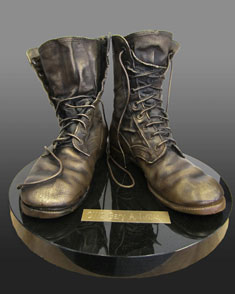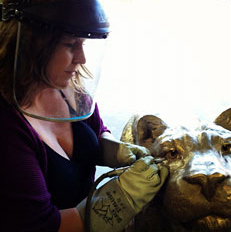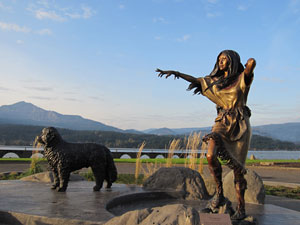Heather Soderberg: A Series of Bronze Firsts
 Marine's Boots. Bronze sculpture by Heather Soderberg.
Marine's Boots. Bronze sculpture by Heather Soderberg.Photograph courtesy of Heather Soderberg
Heather Soderberg has the distinction of being the first female in the U.S. to own a bronze foundry. This is just the latest in a long line of distinctions over her life which eventually brought her to the shores of the Columbia River in Cascade Locks, Oregon where her Soderberg Gallery & Studio is located. But it’s been a long and winding road.
Her father was a welder working at a bronze foundry in Flagstaff, Arizona and he used to bring Heather to work when she was old enough to crawl. “I was basically raised in a foundry by the wax lady,” she says. “Growing up in the foundry, learning to sculpt in the foundry, and being around all the art was my main inspiration.
She began to work with clay and by age seven her sculpture had inadvertently received national acclaim when two different gallery owners in Arizona and Texas put her work in their respective galleries. This caught the attention of People Magazine, National Geographic World, and the TV show That’s Incredible.
“I was a novelty,” she says, admitting that, though her early work may have been good - Moses holding the Ten Commandments, and sculpting bronze images from Greek mythology - it wasn’t great. Though people bought her work, the young Soderberg remained relatively unfazed by the experience. By age nine she had learned to weld bronze from her dad, something she found she enjoyed. Throughout high school she continued to sculpt and make wax molds, but her early successes eventually gave way to a more practical future in law enforcement.
“As I got older I received a degree in criminal science,” she says, and law enforcement had been in her background from her great grandfather, who was one of the first motorcycle cops in California. She took a job with the U.S. Coast Guard in Maui, a far cry from bronze sculpting, though she still did some sculpting on her own. “It really helped my emotions after a crazy day,” she notes, but she realized after a while that she wanted to get back into the art business. “Working in bronze and sculpting, it was what I was meant to do,” she says.
When the owner was ready to forgo the foundry, Heather decided to purchase it.
 Heather at work in her studio.
Heather at work in her studio.Photograph courtesy of Heather Soderberg
“I ended up buying it when the economy was tanking in 2009,” she admits and became the only female foundry owner in the U.S. Soderberg knew that for the business to be viable, she would have to bring about some changes. She downsized the foundry and moved the operation to Cascade Locks from the Portland area, about a 45 minute drive.
“I chose a less expensive area in a different county and a smaller square footage space,” she says. The foundry currently employs five people and she started consulting with other artists to allow them to cast their works, aiming to be “founder friendly.” She’s in the unique position of being able to cast her own bronze works, and to be the foundry of choice for other artists. About 50 percent of her time at the foundry is casting outside work, the rest is up to her. “My studio is right up against the mountains in the Columbia River Gorge. I am frequently not in my studio because of that. I usually get back from hiking later in the day, inspired completely, and I sculpt like a madwoman until the wee hours of night.”
It is Soderberg’s reputation as a bronze sculptor and welder that brings in much outside work to her foundry, including out of state work from New York, and Washington. It may seem odd that East Coast foundries are not the preference for East Coast clients, but her foundry is less expensive, by three times, she says of East Coast foundries. “My main strength is that I have such an extensive history with bronze, and I’m an artist myself. I’m more patient and compassionate towards other clients. I spend extra time so that the artist is happy.”
Another draw is her hands on approach to each project.
“I really get involved and we discuss every aspect of their project. I do most of the final touch up for the foundry pieces. I can fabricate an entire piece out of bronze if I need to.” But like her brief child prodigy days, the experience of being a female foundry owner is something she takes for granted.
It might seem like anyone can learn to weld bronze, but to do it expertly is another matter.
 Sacagawea at Sunset
Sacagawea at SunsetPhotograph courtesy of Heather Soderberg
“I have a feel for it,” Soderberg suggests. “I hyper focus my eyes, making everything flow, so I don’t need to do any grinding and tooling of the bronze pieces. I love sculpting and welding but I also love the technology of the TIG welder, the electricity, the energy.”
She casts with Everdur, a silicon bronze, though she has tried other materials with mixed results. “Those bronze materials with less copper and more zinc get smoky and crackle,” she says. “Bronze is my preference and I love welding on bronze,” she freely admits. “Bronze with the silica sand shell is such an old and historical technology,” she says. “They have unearthed and brought up from the bottom of the ocean bronze art from thousands of years ago. Bronze will outlive all of us.”
She has three monuments in Cascade Locks including perhaps her best known work of a stunning image of Sacagawea over looking the Columbia River. In 2010, the Port of Cascade Locks commissioned Soderberg to create two bronze sculptures of Sacagawea and the dog Seaman, of Lewis and Clark history. These two figures have historical significance in the area as Cascade Locks was a noted stop on Lewis and Clark’s trail. Located adjacent to the Visitor's Center, they overlook the Columbia River in a beautiful outdoor setting. The statues were unveiled and dedicated on the 205th Anniversary of Lewis & Clark’s return trip through Cascade Locks in 1806.
“Because my monuments are here in town I re-wax them twice a year,” she says. Few artists have that luxury but she treats each bronze piece differently. “If it’s a sea piece, a mermaid, seashells or an animal I tend to lacquer then seal it with a clear coat to give it a glossy look. If it’s more contemporary like a wildlife, she prefers wax as a finish to give it a more organic feel, utilizing the subtle patina notes with more ferric chloride so that more gold and bronze colors show through. She uses American Scientific in Portland for her patinas.
Of her own bronze work a full 90 percent is commissioned and clients come from Denmark, Canada, across the U.S., including schools like Washington State where she created a cougar descending down a mountainside, government, and private collectors.
“I’ve worked hard, 80 hour weeks,” she says. “It’s my whole life, so the success is paying off.” Many artists can’t afford to be in multiple galleries and they rely on art shows, but her foundry allows her to create her own pieces at will. “Having the foundry was really the start of my career.”
Resources:
Also in this Issue:
- Heather Soderberg: A Series of Bronze Firsts
- Love of Human Form Basis of Sculptor’s Career
- The Bronze Touch: Classic to Contemporary Sculpture by Michael Alfano
- Matthew Albright: Nature’s Beauty Swimming in Copper
- Metal Fiber Art by Ted Hallman On View in the Pfundt Gallery of the Michener Art Museum
